Recently, I’ve been trying to step out of my comfort zone and get used to things that I never got used to before. Just to be clear, the comfort zone that I was talking about are my cooking and eating habits. Not anything else. There is one particular ingredient, I’m pretty sure not even a teeny tiny piece of it passed my teeth until I turned 11, that is tofu. For a weird reason, I never liked tofu. I can’t barely swallow it happily, let alone cooking or making it from scratch. Up until the day before yesterday, the thought of making any kind of tofu at home would make my past-self laughing so hard. That is why the first thing on my “Leave my comfort zone” list is making and enjoying soybean pudding dohua.

So the first recipe about tofu that I want to make is the popular street food you can find in China as well as Vietnam: Soybean pudding or Tofu pudding. It’s called Douhua in Chinese and Tàu hủ nước đường in Vietnamese. These soybean pudding dohua have softer and silkier texture compared to regular soft/silken tofu. They do have same commons ingredients: soy milk and coagulation agent. The tricky part in making this recipe and tofu in general, is that you must have the right coagulants.
I have a wonderful fresh homemade soy milk recipe that you can check it out. Light soy milk is the version that is called and more suitable for this pudding recipe.
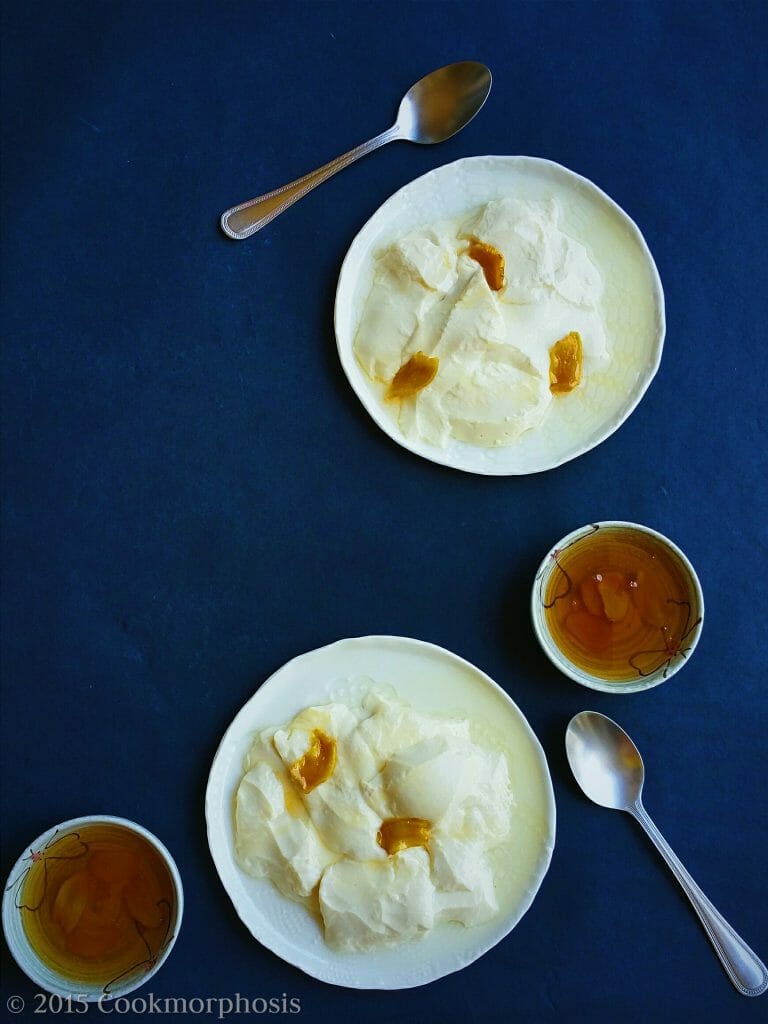
So what is coagulant agent?
Coagulants help to solidify the protein and oil in hot soy milk to make soft, firm, and silken tofu.
So how many coagulants out there?
The most basic ingredients you can easily buy and use to make soybean pudding and/or tofu are white vinegar and lemon juice. But not many people have successful products after the coagulate process so I did not advise you use these. Besides this, we have 3 popular tofu coagulants.
The other three most common agents that most tofu maker experts prefer are:
- Gypsum (calcium sulphate): I did not have any luck to find in any market. So I recommend you to buy it online, I found they have food-grade gypsum on Amazon; and the end result for my pudding was remarkable.
- Epsom salts: You can easily buy Epsom salts in any grocery store, drugstore or pharmacy.
- Nigari; a clear liquid comes in bottle. You can find this in Japanese or Korean market. And of course Amazon.

The technique of making soybean pudding is actually very simple, but it took hours and hours to master, and in my case it was more than 48 hours. I spent 5 times to try making pudding, and hope it turned out well and fail and then try again. From this moment, I proudly announce I am a certified soybean pudding maker (if it is actually a thing).
So here is a list of dos and don’ts for this “Soybean pudding Dohua in ginger syrup”:
- Don’t use store-bought soy milk because it is usually thinner than fresh homemade soy milk which could result as non-settable pudding. However, there are recipes that turn out very ok with store-bough soy milk, so if you decide to go with it, please do at your own risk.
- Don’t use gelatin or agar agar instead of gypsum in the hope for setting your pudding. Unless you want to end up with soy milk jelly or panna cotta. Gelatin and agar agar will not coagulate hot soy milk, what they do is thickening the hot liquid into gelatin texture. (I’m guilty of this so please, never use these if you plan to make traditional soy milk douhua pudding).
- Don’t stir gypsum mixture into hot soy milk because as long as they ‘meet’ each other, the hot milk mixture will coagulate and set immediately. Doing so would end up with weird texture all over your pudding (think about when you stir egg white in hot water, it’s exactly the same). Instead, put the gypsum mixture on the bottom of your pot, then pour hot soy milk at least 10 inches above the pot to create a strong flow of liquid. This step will help to mix ingredients together without physically touch and interfere with the pudding texture.
Do use tapioca starch together with gypsum to have a silkier and firmer pudding. The more you use, the silkier your douhua pudding will be. I used 2 tsp for 5 cups of soy milk. You can use more. But don’t use too much or you end up with soy milk gravy. Always keep your soy milk: starch ratio less than 1:40. How do I know? Well, I did a lot of math, thinking and researches in 48-hour-affair with this pudding. And do make your soy milk one day ahead.
I know this is a very long post because I sincerely want to make your life easier and not end up with unhappy mood (like I did). I hope you find this post useful as a guide to be a master in making soybean Douhua pudding.

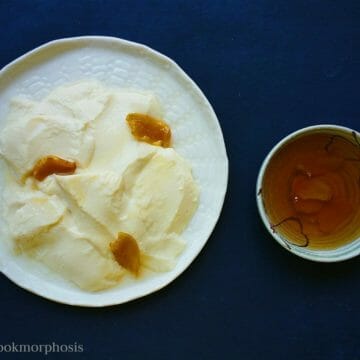
Dohua - Soybean Pudding with Ginger Syrup
Equipment
- Cooking pot
- Paper towel
Ingredients
- 5 c fresh homemade light soy milk see note above
- 2 tsp gypsum
- 2 tsp tapioca starch check Dos & Don'ts list above
- 2 oz water
- 2 tbsp sugar optional
Ginger syrup
- 4 oz brown crystal sugar
- 10 oz water
- 1 oz ginger thinly sliced
Instructions
- In a medium pot, heat soy milk on medium high heat, bring to boil, add sugar (optional) and constantly stirring to prevent soy milk from burning and forming skin.
- In another medium pot, whisk together water, gypsum and tapioca starch.
- When soy milk is finally boiling, turn off the heat. Immediately pour hot soy milk at least 10 inches above the pot into the gypsum mixture (check Dos and Don’ts list for explanation).
- Cover the pot immediately with 1 layer of paper towel (to prevent evaporated water dropping down to pudding) and a lid. If bubble formed after you poured hot soy milk, don’t be panic. You can skim these out of the surface easily after soybean has set. Let the tofu sit, undisturbed, for 30 minutes or more. The more pudding sits, the less water it will produce when scooping out of the pot.
- Make ginger syrup: in a small sauce pan, put sugar and water together on a medium high heat setting. When sugar dissolved completely, add ginger, simmer and reduce the liquid by half. Remove from heat, keep it warm if serve pudding hot or let it cool completely if serve pudding cold.
- Use a flat, thin, stainless steel spoon to scoop out a thin layer of pudding to serving bowl. Top with ginger syrup. Scoop pudding right before serving to minimize the amount of water produced. Keep pudding warm or reheat in microwave if want to serve hot. Put pudding in refrigerator if want to serve cold. Enjoy!

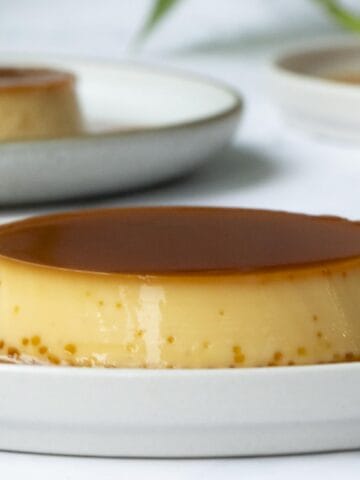

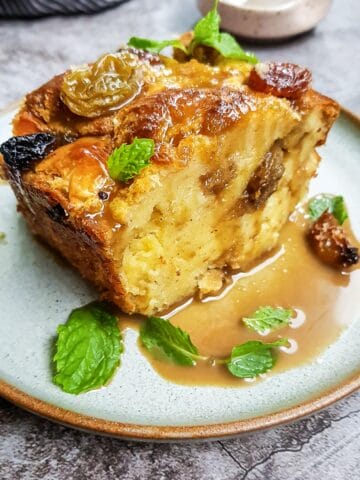
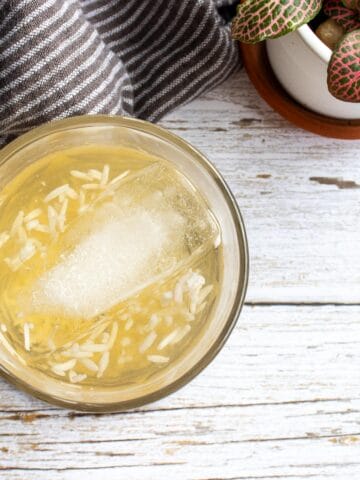
If I were to use lemon as my coagulant instead of gypsum, how much lemon juice should I use?
Hi Rosetta,
Sorry for late reply. Somehow I missed your comment. Anyhow, I did not really use lemon juice as a replacement for gypsum so I don't have the correct answer for you this time thou :(.